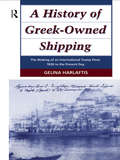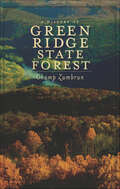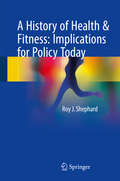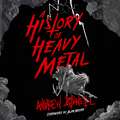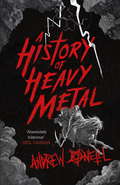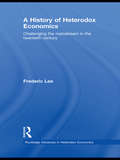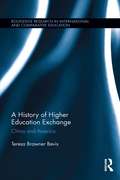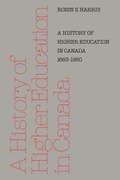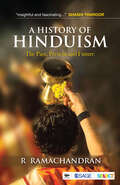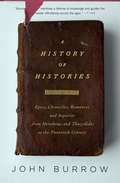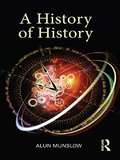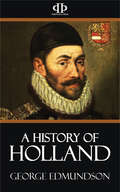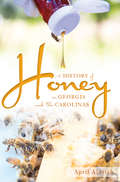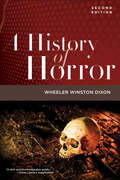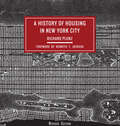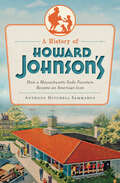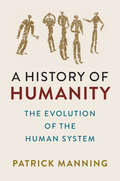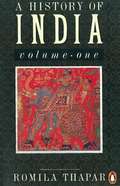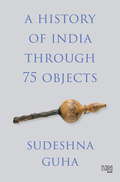- Table View
- List View
A History of Greek Philosophy
by W.K.C. GuthrieThe fourth volume of Professor Guthrie's great history of Greek thought deals exclusively with Plato. Plato, however, so prolific a writer, so profoundly original in his thought, and so colossal an influence on the later history of philosophy, that it has not been possible to confine him to one volume. Volume IV therefore offers a general introduction to his life and writings, and covers the so-called 'early' and 'middle' periods of his philosophical development (up to and including the Republic).
A History of Greek-Owned Shipping: The Making of an International Tramp Fleet, 1830 to the Present Day (Maritime History Ser.)
by Gelina HarlaftisGreek-owned shipping has been at the top of the world fleet for the last twenty years. Winner of the 1997 Runciman Award, this richly sourced study traces the development of the Greek tramp fleet from the mid-nineteenth century to the present day. Gelina Harlaftis argues that the success of Greek-owned shipping in recent years has been a result not of a number of entrepreneurs using flags of convenience in the 1940s, but of networks and organisational structures which date back to the nineteenth century. This study provides the most comprehensive history of development of modern Greek shipping ever published. It is illustrated with numerous maps and photographs, and includes extensive tables of primary data.
A History of Green Ridge State Forest
by Champ ZumbrunJoin former forest manager Champ Zumbrun as he traverses hidden trails to tell the remarkable story of Green Ridge State Forest.Green Ridge State Forest is a haven of calm and natural beauty among the Appalachians of western Maryland. This land was once the frontier of the nation, and trailblazers such as Thomas Cresap and George Washington were among the first Europeans to discover its wonders: the swift Potomac, the flowering dogwood and pine in the mountain reaches and the nighttime calls of the bobcat and the barred owl. The vision and stewardship of people like forester Fred W. Besley preserved the forest for future generations of hikers, explorers and families. Join former forest manager Champ Zumbrun as he traverses hidden trails to tell the remarkable story of Green Ridge State Forest.
A History of Groves (Routledge Research in Landscape and Environmental Design)
by Jan Woudstra Colin RothThe grove, a grouping of trees, intentionally cultivated or found growing wild, has a long diverse history entwined with human settlement, rural practices and the culture and politics of cities. A grove can be a memorial, a place of learning, a site of poetic retreat and philosophy or political encampment, a public park or theatre, a place of hidden pleasures, a symbol of a vanished forest ecology, or a place of gods or other spirits. Yet groves are largely absent from our contemporary vocabulary and rarely included in today’s landscape practice, whether urban or rural. Groves are both literal and metaphorical manifestations, ways of defining spaces and ecologies in our cultural life. Since they can add meaning to urban forms and ecologies and contribute meaningfully to the significance of place, critical examination is long overdue. The editors have taken care to ensure that the text is accessible to the general reader as well as specialists.
A History of Hawaii 2nd Edition
by Linda Menton Eileen TamuraA comprehensive and readable account of the history of Hawai'i presented in three chronological units: Unit 1, Pre-contact to 1900; Unit 2, 1900¿1945; Unit 3, 1945 to the present. Each unit contains chapters treating political, economic, social, and land history in the context of events in the United States and the Pacific Region. The student book features primary documents, political cartoons, stories and poems, graphs, a glossary, maps, and timelines. The activities, writing assignments, oral presentations, and simulations foster critical thinking.
A History of Health & Fitness: Implications for Policy Today
by Roy J. ShephardThis book provides a unique and succinct account of the history of health and fitness, responding to the growing recognition of physicians, policy makers and the general public that exercise is the most potent form of medicine available to humankind. Individual chapters present information extending from the earliest reaches of human history to the present day, arranged in the form of 30 thematic essays covering topics from the supposed idyll of the hunter-gatherer lifestyle and its posited health benefits to the evolution of health professionals and the possible contribution of the Olympic movement to health and fitness in our current society. Learning objectives are set for each topic, and although technical language is avoided as far as possible, a thorough glossary explains any specialized terms that are introduced in each chapter. The critical thinking of the reader is stimulated by a range of questions arising from the text context, and each chapter concludes with a brief discussion of some of the more important implications for public policies on health and fitness today and into the future. The material will be of particular interest to graduate and undergraduate students in public health, health promotion, health policy, kinesiology, physical education, but will be of interest also to many studying medicine, history and sociology.
A History of Heavy Metal
by Andrew O'NeillThe history of heavy metal brings brings us extraordinary stories of larger-than-life characters living to excess, from the household names of Ozzy Osbourne, Lemmy, Bruce Dickinson and Metallica (SIT DOWN, LARS!), to the brutal notoriety of the underground Norwegian black metal scene and the New Wave Of British Heavy Metal. It is the story of a worldwide network of rabid fans escaping everyday mundanity through music, of cut-throat corporate arseholes ripping off those fans and the bands they worship to line their pockets. <p><p>The expansive pantheon of heavy metal musicians includes junkies, Satanists and murderers, born-again Christians and teetotallers, stadium-touring billionaires and toilet-circuit journeymen. Award-winning comedian and life-long heavy metal obsessive Andrew O'Neill has performed his History of Heavy Metal comedy show to a huge range of audiences, from the teenage metalheads of Download festival to the broadsheet-reading theatre-goers of the Edinburgh Fringe. <p><p>Now, in his first book, he takes us on his own very personal and hilarious journey through the history of the music, the subculture, and the characters who shaped this most misunderstood genre of music.
A History of Heavy Metal: 'Absolutely hilarious' – Neil Gaiman
by Andrew O'Neill'Absolutely hilarious' - Neil Gaiman'One of the funniest musical commentators that you will ever read . . . loud and thoroughly engrossing' - Alan Moore'A man on a righteous mission to persuade people to "lay down your souls to the gods rock and roll".' - The Sunday Times'As funny and preposterous as this mighty music deserve' - John HiggsThe history of heavy metal brings brings us extraordinary stories of larger-than-life characters living to excess, from the household names of Ozzy Osbourne, Lemmy, Bruce Dickinson and Metallica (SIT DOWN, LARS!), to the brutal notoriety of the underground Norwegian black metal scene and the New Wave Of British Heavy Metal. It is the story of a worldwide network of rabid fans escaping everyday mundanity through music, of cut-throat corporate arseholes ripping off those fans and the bands they worship to line their pockets. The expansive pantheon of heavy metal musicians includes junkies, Satanists and murderers, born-again Christians and teetotallers, stadium-touring billionaires and toilet-circuit journeymen. Award-winning comedian and life-long heavy metal obsessive Andrew O'Neill has performed his History of Heavy Metal comedy show to a huge range of audiences, from the teenage metalheads of Download festival to the broadsheet-reading theatre-goers of the Edinburgh Fringe. Now, in his first book, he takes us on his own very personal and hilarious journey through the history of the music, the subculture, and the characters who shaped this most misunderstood genre of music.
A History of Herbalism: Cure, Cook and Conjure
by Emma KayFood historian Emma Kay tells the story of our centuries-old relationship with herbs. From herbalists of old to contemporary cooking, this book reveals the magical and medicinal properties of your favourite plants in colorful, compelling detail. At one time, every village in Britain had a herbalist. A History of Herbalism investigates the lives of women and men who used herbs to administer treatment and knew the benefit of each. Meet Dr Richard Shephard of Preston, who cultivated angelica on his estate in the eighteenth century for the sick and injured; or Nicholas Culpeper, a botanist who catalogued the pharmaceutical benefits of herbs for early literary society. But herbs were not only medicinal. Countless cultures and beliefs as far back as prehistoric times incorporated herbs into their practices: paganism, witchcraft, religion and even astrology. Take a walk through a medieval ‘physick’ garden, or Early Britain, and learn the ancient rituals to fend off evil powers, protect or bewitch or even attract a lover. The wake of modern medicine saw a shift away from herbal treatments, with rituals and spells shrouded with superstition as the years wore on. The author reveals how herbs became more culinary rather than medicinal including accounts of recent trends for herbal remedies as lockdown and the pandemic leads us to focus more on our health and wellbeing.
A History of Heterodox Economics: Challenging the mainstream in the twentieth century (Routledge Advances in Heterodox Economics)
by Frederic LeeEconomics is a contested academic discipline between neoclassical economics and a collection of alternative approaches, such as Marxism-radical economics, Institutional economics, Post Keynesian economics, and others, that can collectively be called heterodox economics. Because of the dominance of neoclassical economics, the existence of the alternative approaches is generally not known. This book is concerned with the community history of heterodox economics, seen primarily through the eyes of Marxian-radical economics and Post Keynesian economics. Throughout the 20th century neoclassical economists in conjunction with state and university power have attacked heterodox economists and tried to cleanse them from the academy. Professor Lee, his groundbreaking new title discusses issues including the contested landscape of American economics in the 1970s, the emergence and establishment of Post Keynesian economics in the US and the development of heterodox economics in Britain from 1970 to 1996.
A History of Higher Education Exchange: China and America (Routledge Research in International and Comparative Education)
by Teresa Brawner BevisWeakened by two Opium Wars and a succession of internal rebellions in the mid-1800s, China’s imperial leaders made a historic decision—to break a tradition of isolation and seek education outside the homeland’s borders. In time, an acquisition of science and technology from the rapidly-industrializing West would enable China to modernize its still-feudal economy and outdated military, thus restoring stability and establishing protection from future foreign encroachment. Today more than 200,000 Chinese are enrolled in colleges and universities across the United States, while the number of Americans choosing to study in China is rising. As we approach mid-century China is assuming a lofty position of world leadership. This book does not attempt to debate or determine the extent to which higher education exchange with the United States has impacted China’s rise . Instead it focuses on the story itself—of Sino-American education trade from its roots in antiquity to the present time—highlighting the people, programs, trials and triumphs that have wrought its extraordinary history. It will offer the first sequential, historically grounded book-length review of Sino-American education exchange that takes the story from its origins to the present day.
A History of Higher Education in Canada 1663-1960
by Robin HarrisThis book traces the development of higher education in Canada, through a detailed description and analysis of what was being taught and of the research opportunities available to professors in the years from 1860 to 1960. Background is provided in the opening chapters of Part I, which outline the origins of post-secondary education in both French and English Canada from 1635 to 1860, and in the parallel chapters of Parts II to V which describe the establishment of new and the growth of existing institutions during the period 1861-90, 1891-1920, 1921-40, and 1941-60. The remaining chapters of each of the book's main divisions present an examination of the curricula in arts and science, professional education, and graduate studies in 1860, 1890, 1920, 1940, and 1960, as well as the conditions pertaining to scholarship and research in these years. The concluding chapter identifies the characteristics which differentiate Canadian higher education from that of other countries. The book includes a full bibliography, an extensive index, and statistical appendices providing data on enrolment and degrees granted. A History of Higher Education in Canada 1663-1960 will be the definitive work in its field, valuable both for the wealth of information and the historical insights it contains.
A History of Hinduism: The Past, Present, and Future
by R RamachandranIS THE HISTORY OF HINDUISM, THE HISTORY OF BRAHMANAS FROM RIGVEDIC TIMES TO THE PRESENT? Or, does the story of Hinduism begin with the descriptions of the ancient roots as revealed by archaeological findings and the evidence from present day tribal, village and regional cultures? This book looks at both. The history of Brahmanas, tracing their lineage to the fifty-odd Rigvedic poets, is dealt with through the chronological ordering of the Sanskrit texts which were first handed down to us as oral narratives from Gurus to shishyas. The circumstances and purposes for which these texts were written is examined, along with events of a true historical nature. This is followed by a sequential treatment of Hinduism as a ‘Rigvedic religion’, the two Mimamsas, Buddhism, Jainism, Dharmasastras, the Epics and the Puranas. The growth of Hindu temples, the role of Adi Sankaracharya and the Bhakti movement is delved into, and the influences of Muslim and British rule of the subcontinent on Hinduism is analysed. The author explores one major reason for the survival of Hinduism—the support of prehistoric tribal and village cultures which were not modified or destroyed by the later-day Brahmanas. Much of tribal and village deities and practices were co-opted into concurrent Hinduism, so-much-so that today these cannot be separated from mainstream Hindu practices and traditions. They exist in all their colourful glory to this date and make Hinduism vibrant. It is these ancient folk religions that provide a stable foundation for the survival of Hinduism, argues author R Ramachandran, presenting in this book an all-encompassing landscape view of Hinduism as it has been for the last five thousand years. Finally, the present status of Hinduism is discussed along with its survival in the future.
A History of Histories: Epics, Chronicles, and Inquiries from Herodotus and Thucydides to the Twentieth Century
by J. W. BurrowTreating the practice of history not as an isolated pursuit but as an aspect of human society and an essential part of the culture of the West, John Burrow magnificently brings to life and explains the distinctive qualities found in the work of historians from the ancient Egyptians and Greeks to the present. With a light step and graceful narrative, he gathers together over 2,500 years of the moments and decisions that have helped create Western identity. This unique approach is an incredible lens with which to view the past. Standing alone in its ambition, scale and fascination, Burrow's history of history is certain to stand the test of time.
A History of History
by Alun MunslowIn a provocative analysis of European and American historical thinking and practice since the early 18th century, A History of History confronts several basic assumptions about the nature of history. Among these are the concept of historical realism, the belief in representationalism and the idea that the past possesses its own narrative. What is offered in this book is a far-reaching and fundamental rethinking of realist and representationalist ‘history of a particular kind’ by addressing and explaining the ideas of major philosophers of history over the past three hundred years and those of the key theorists of today. In pursuing this radical analysis, the understanding of history as a narrative is evaluated along with contemporary notions such as the continuing presence of the past and the idea of ‘its lessons’. Written by one of the leading thinkers on the subject, A History of History provides an accessible and radical history of history while offering new insights into the pressing questions of the nature, purpose and function of history. This book is an essential text for all students, teachers and consumers of history.
A History of Holland
by George EdmundsonThe title, "History of Holland," given to this volume is fully justified by the predominant part which the great maritime province of Holland took in the War of Independence and throughout the whole of the subsequent history of the Dutch state and people. In every language the country, comprising the provinces of Holland, Zeeland, Utrecht, Friesland, Gelderland, Overyssel and Groningen, has, from the close of the sixteenth century to our own day, been currently spoken of as Holland, and the people (with the solitary exception of ourselves) as 'Hollanders.' It is only rarely that the terms the Republic of the United Provinces, or of the United Netherlands, and in later times the Kingdom of the Netherlands, are found outside official documents. Just as the title "History of England" gradually includes the histories of Wales, of Scotland, of Ireland, and finally of the widespread British Empire, so is it in a smaller way with the history that is told in the following pages. That history, to be really complete, should begin with an account of mediaeval Holland in the feudal times which preceded the Burgundian period; and such an account was indeed actually written, but the plan of this work, which forms one of the volumes of a series, precluded its publication.
A History of Honey in Georgia and the Carolinas (American Palate)
by April AldrichIn the late 1800s, Georgia and the Carolinas produced millions of pounds of honey and created a lasting legacy within the industry. The uses for the sweet nectar go well beyond flavor. Bee pollination extensively benefits agricultural crops in the area. Elements from the beehive are commonly used in popular cosmetics, medicines and mead. Beekeepers also face serious challenges like Colony Collapse Disorder. Join author and beekeeper April Aldrich as she traces the delectable history of honey and beekeeping throughout the region, from ancient apiaries to modern meaderies and beyond.
A History of Horror, 2nd Edition
by Wheeler Winston DixonEver since horror leapt from popular fiction to the silver screen in the late 1890s, viewers have experienced fear and pleasure in exquisite combination. Wheeler Winston Dixon's fully revised and updated A History of Horror is still the only book to offer a comprehensive survey of this ever-popular film genre. Arranged by decades, with outliers and franchise films overlapping some years, this one-stop sourcebook unearths the historical origins of characters such as Dracula, Frankenstein, and the Wolfman and their various incarnations in film from the silent era to comedic sequels. In covering the last decade, this new edition includes coverage of the resurgence of the genre, covering the swath of new groundbreaking horror films directed by women, Black and queer horror films, and a new international wave in body horror films. A History of Horror explores how the horror film fits into the Hollywood studio system, how the distribution and exhibition of horror films have changed in a post-COVID world, and how its enormous success in American and European culture expanded globally over time. Dixon examines key periods in the horror film-in which the basic precepts of the genre were established, then banished into conveniently reliable and malleable forms, and then, after collapsing into parody, rose again and again to create new levels of intensity and menace. A History of Horror, supported by rare stills from classic films, brings over sixty timeless horror films into frightfully clear focus, zooms in on today's top horror Web sites, and champions the stars, directors, and subgenres that make the horror film so exciting and popular with contemporary audiences.
A History of Housing in New York City (Columbia History of Urban Life)
by Richard PlunzSince its emergence in the mid-nineteenth century as the nation's "metropolis," New York has faced the most challenging housing problems of any American city, but it has also led the nation in innovation and reform. The horrors of the tenement were perfected in New York at the same time that the very rich were building palaces along Fifth Avenue; public housing for the poor originated in New York, as did government subsidies for middle-class housing.A standard in the field since its publication in 1992, A History of Housing in New York City traces New York's housing development from 1850 to the present in text and profuse illustrations. Richard Plunz explores the housing of all classes, with comparative discussion of the development of types ranging from the single-family house to the high-rise apartment tower. His analysis is placed within the context of the broader political and cultural development of New York City. This revised edition extends the scope of the book into the city's recent history, adding three decades to the study, covering the recent housing bubble crisis, the rebound and gentrification of the five boroughs, and the ecological issues facing the next generation of New Yorkers. More than 300 illustrations are integrated throughout the text, depicting housing plans, neighborhood changes, and city architecture over the past 130 years. This new edition also features a foreword by the distinguished urban historian Kenneth T. Jackson.
A History of Howard Johnson's: How a Massachusetts Soda Fountain Became an American Icon (American Palate Ser.)
by Anthony Mitchell SammarcoThe iconic restaurant chain that defined Americana by introducing twenty-eight flavors of ice cream, &“tendersweet&” clam strips, grilled &“frankforts,&” and more. Popularly known as the &“Father of the Franchise Industry,&” Howard Johnson delivered good food and fair prices—a winning combination that brought appreciative customers back for more. The attractive white Colonial Revival restaurants, with eye-catching porcelain tile roofs, illuminated cupolas, and sea blue shutters, were described in Reader&’s Digest in 1949 as the epitome of &“eating places that look like New England town meeting houses dressed up for Sunday.&” Learn how Johnson created an orange-roofed empire of ice cream stands and restaurants that stretched from Maine to Florida . . . then all the way across the country.
A History of Humanity: The Evolution of the Human System
by Patrick ManningHumanity today functions as a gigantic, world-encompassing system. Renowned world historian, Patrick Manning traces how this human system evolved from Homo Sapiens' beginnings over 200,000 years ago right up to the present day. He focuses on three great shifts in the scale of social organization - the rise of syntactical language, of agricultural society, and today's newly global social discourse - and links processes of social evolution to the dynamics of biological and cultural evolution. Throughout each of these shifts, migration and social diversity have been central, and social institutions have existed in a delicate balance, serving not just their own members but undergoing regulation from society. Integrating approaches from world history, environmental studies, biological and cultural evolution, social anthropology, sociology, and evolutionary linguistics, Patrick Manning offers an unprecedented account of the evolution of humans and our complex social system and explores the crises facing that human system today.
A History of Hunting in the Great Smoky Mountains (Sports Ser.)
by Bob PlottDiscover the history and lore of this region&’s legendary outdoorsmen—and their faithful dogs: &“Well worth reading&” (Bear Hunting Magazine). Man versus beast—it&’s an age-old struggle that has been part of the rugged terrain of the Great Smoky Mountains since humans first encountered the region centuries ago. Bob Plott, a descendant of the breeder of the Plott hound and an avid outdoorsman in North Carolina, takes readers on a quest back through time for a glimpse into the minds and the rifles of the region&’s most intrepid hunters. From the primitive weaponry and prevailing tactics of the Cherokee to the audacious rifle-toting ridge runners, and even a gruesome gang of cannibalistic rogues, these stories are truly a gripping tribute to mountain life and the adventure of the game.
A History of India
by Dietmar Rothermund Hermann KulkePresenting the grand sweep of Indian history from antiquity to the present, A History of India is a detailed and authoritative account of the major political, economic, social and cultural forces that have shaped the history of the Indian subcontinent. Hermann Kulke and Dietmar Rothermund provide a comprehensive overview of the structural pattern of Indian history, covering each historical period in equal depth. Fully revised throughout, the sixth edition of this highly accessible book has been brought up to date with analysis of recent events such as the 2014 election and its consequences, and includes more discussion of subjects such as caste and gender, Islam, foreign relations, partition, and the press and television. This new edition contains an updated chronology of key events and a useful glossary of Indian terms, and is highly illustrated with maps and photographs. Supplemented by a companion website (www.routledge.com/cw/kulke), it is a valuable resource for students of Indian history.
A History of India
by Romila ThaparA history of India upto 1300 AD introducing the beginnings of India's cultural dynamics
A History of India through 75 Objects
by Sudeshna GuhaWith a curation of objects from the prehistoric ages through twenty-first century India, Sudeshna Guha provides a panoramic view of the rich histories of the subcontinent. The incisive essays in this collection detail not just the objects but the histories of their reception: examining how changing times and attitudes cast their shadow on the ways in which the past is interpreted and narrated. In doing so, A History of India through 75 Objects inspires us to interrogate our own notions of a knowable past and fixed national history. Teeming with thought-provoking insights and surprising anecdotes, the essays instill a sense of wonder about the continuous processes by which histories are constructed.

